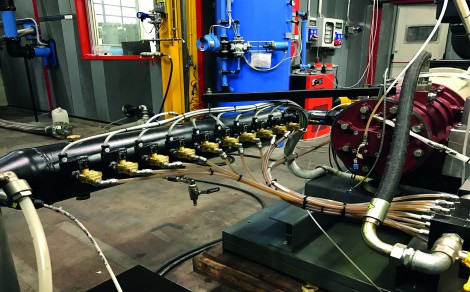Pushing the boundaries of compressor efficiency

Intercooling is a common practice in compressor technology for reducing the power required for operation. However, the latest research by Mattei, in conjunction with the Polytechnic University of Milan, shows that the similar concept of ‘intracooling’ achieves even better results in two-stage compressors. Andy Jones, managing director at Mattei, explains how it works, improves energy efficiency, and what’s in store for further development.
Compressed air is a widely used and important source of energy in a multitude of industries. It uses a huge amount of energy and although sliding vane rotary compressors (SVRC) are already highly efficient, there is still plenty of room for raising their energy performance.
With this in mind, research carried out by Mattei has identified that redesigning two-stage compressors can deliver extra savings through mechanical and electrical efficiency.
From Intercooling to intracooling
Intercooling is commonly employed to optimise the energy efficiency of compressors by first separating the air from oil, then reducing the temperature of the compressed gas between the low- and high-pressure stages of compression using a heat exchanger. Typically, water or air acts as the coolant. With intercooling, the thermal power is transferred from the gas to the environment.
In intracooling, small droplets of cooled lubricant oil are sprayed into the gas flow within an intracooling duct to cool the compressed gas between the two compression stages. Crucially, the oil is not separated from the gas after the first stage. It is left in the flow to lubricate the next compression stage and lower the compressed air’s temperature, before it is separated from the compressed gas at the end. Overall, thermal power is transferred from the gas to the liquid and not to the environment, avoiding the presence of a dedicated cooling system between the two stages and auxiliary power needed for it.
Test set-up
To prove the theory, Mattei set up a study on the effectiveness of intracooling. A prototype of a sliding-vane air compressor was created and equipped with the instruments required to measure the temperature and pressure of air and lube-oil in all key points of the circuit, as well as the injected oil flow rate and the electrical power.
Thirteen different configurations of the pressure swirl nozzles which inject the oil in the intracooling duct were tested, all with the same pressure and temperature injection conditions.
Positive results
Comparing the results with a conventional single-stage compressor, a two-stage compressor with intracooling is shown to deliver energy savings of up to 10%. Remarkably, 2.3% less input power is needed with an intracooled system compared to an intercooled one due to a better compression process. This is because at the low-pressure stage, the intracooled compressor can inject the oil at a higher pressure, leading to a finer atomisation of the oil for better heat transfer. In intercooling, the pressure at the end of the first compression stage has to be increased because of the pressure drop on the cooling fan. This means that more power is needed to compress the air at the second stage. In intracooling, no pressure drop occurs into the connection duct, so the pressures are matched between the two stages. What’s more, this innovative method reduces temperatures by up to 10degC across the duct between the two stages.
So, what do these findings mean for the efficiency of sliding-vane rotary compressors? Because an intracooled compressor delivers a better compression process compared to the intercooled one at the low-pressure stage, less power is ultimately used. The possibility of extending the operating range of pressure is also enabled and there are fewer pieces of equipment to operate and maintain.
Following on from these positive results, the team will focus on the design of the high-pressure stage in the future to uncover opportunities where further energy savings can be made. Given that the effectiveness of the intracooling process heavily depends on the number of active nozzles and their positions, which consequently affects the oil flow rate, Mattei is looking to develop a smart system to control the nozzles. With more research in the pipeline, the system could be even better. Watch this space.
-
PPMA 2025
23 September, 2025, 9:30 - 25 September, 2025, 16:00
NEC, Birmingham UK -
Advanced Engineering Show 2025
29 October, 2025, 9:00 - 30 October, 2025, 16:00
NEC, Birmingham UK










